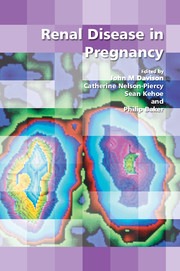Book contents
- Frontmatter
- Contents
- Participants
- Preface
- SECTION 1 RENAL PHYSIOLOGY IN PREGNANCY
- SECTION 2 PATTERNS OF CARE
- 2 Prepregnancy counselling and risk assessment: general overview
- 3 Chronic kidney disease in pregnancy: patterns of care and general principles of management
- 4 Midwifery issues
- 5 Postpartum follow-up of antenatally identified renal problems
- SECTION 3 CHRONIC KIDNEY DISEASE
- SECTION 4 DRUGS USED IN RENAL DISEASE IN PREGNANCY
- SECTION 5 ACUTE RENAL IMPAIRMENT
- SECTION 6 UROLOGY AND PREGNANCY
- SECTION 7 SURGICAL AND MEDICAL ISSUES SPECIFIC TO RENAL TRANSPLANT PATIENTS
- SECTION 8 CONSENSUS VIEWS
- Index
2 - Prepregnancy counselling and risk assessment: general overview
from SECTION 2 - PATTERNS OF CARE
Published online by Cambridge University Press: 05 September 2014
- Frontmatter
- Contents
- Participants
- Preface
- SECTION 1 RENAL PHYSIOLOGY IN PREGNANCY
- SECTION 2 PATTERNS OF CARE
- 2 Prepregnancy counselling and risk assessment: general overview
- 3 Chronic kidney disease in pregnancy: patterns of care and general principles of management
- 4 Midwifery issues
- 5 Postpartum follow-up of antenatally identified renal problems
- SECTION 3 CHRONIC KIDNEY DISEASE
- SECTION 4 DRUGS USED IN RENAL DISEASE IN PREGNANCY
- SECTION 5 ACUTE RENAL IMPAIRMENT
- SECTION 6 UROLOGY AND PREGNANCY
- SECTION 7 SURGICAL AND MEDICAL ISSUES SPECIFIC TO RENAL TRANSPLANT PATIENTS
- SECTION 8 CONSENSUS VIEWS
- Index
Summary
Introduction
Women with kidney disease have an increased risk of adverse maternal and fetal outcomes and it is now recognised that kidney disease is much more common than previously appreciated. By using an estimation of glomerular filtration rate (eGFR) rather than serum creatinine to assess renal function, between 3% and 10% of women of childbearing age might be defined as having chronic kidney disease (CKD). Physicians in both primary and secondary care need to be alert to advising women with renal disease that they might be at risk, but they need guidelines as to who to alert and how to advise on the degree of risk. This chapter will address these issues in more detail. The aim is to advise all women who are at increased risk of that risk prior to conception — not only so that appropriate investigations and medication changes can be implemented safely well in advance but to avoid the emotional trauma of only discovering, once pregnant, that pregnancy might be associated with long-term complications. Importantly, many women with kidney disease may be entirely unaware that their condition could affect a pregnancy.
Who should have prepregnancy counselling?
The role of prepregnancy advice is to make a woman and her partner aware of the risks a pregnancy may pose to her health and that of the fetus, to give guidance as to the best time to contemplate pregnancy (i.e. sooner, if she has progressive renal disease, or later, if she has a relapsing condition that has recently flared), and to provide the opportunity to optimise treatment to ensure she is not on teratogenic medications at the time of conception and to focus her on the need for optimal control of risk factors such as hypertension and hyperglycaemia.
- Type
- Chapter
- Information
- Renal Disease in Pregnancy , pp. 21 - 30Publisher: Cambridge University PressPrint publication year: 2008
- 2
- Cited by

